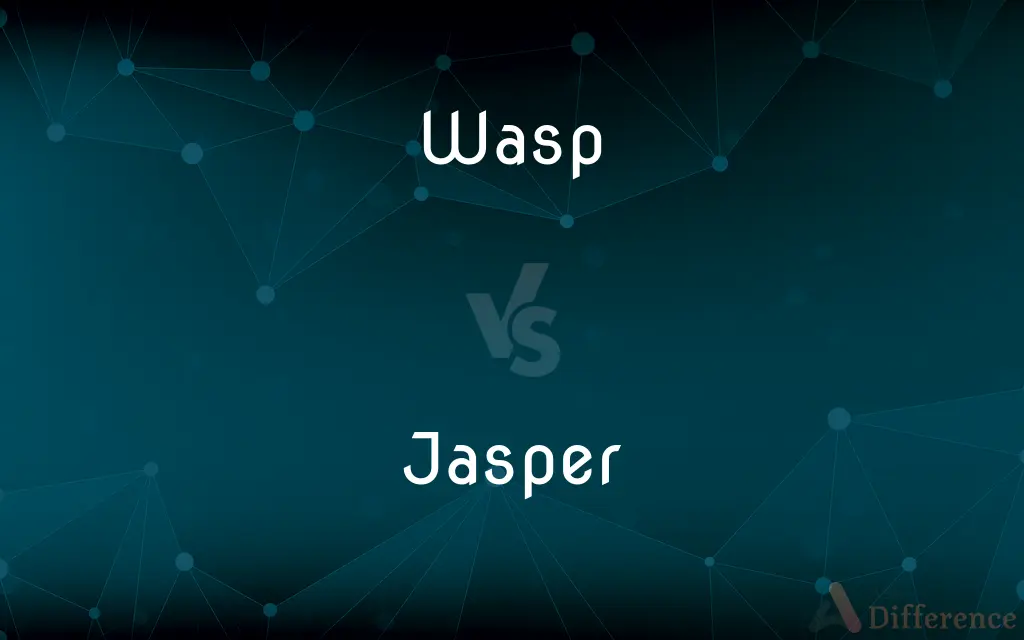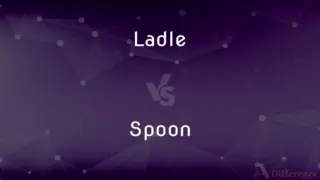Wasp vs. Jasper — What's the Difference?
By Tayyaba Rehman & Maham Liaqat — Updated on April 23, 2024
Wasp is an insect known for its role in pollination and sometimes aggressive behavior, whereas jasper is a type of opaque, often multicolored mineral used in jewelry and ornamentation.

Difference Between Wasp and Jasper
Table of Contents
ADVERTISEMENT
Key Differences
Wasp is a type of flying insect associated with its slender body and stinging capability, often seen as a pest due to its aggressive behavior and potential to sting. Whereas, jasper is a form of chalcedony, which is a mineral belonging to the quartz family, valued for its aesthetic qualities and durability in various decorative applications.
While wasps are biologically important for their role in pollination and as natural predators of other pests, jasper holds significance primarily in the fields of gemology and decorative arts. It's used in making jewelry, carvings, and other ornamental objects.
Wasps can be found in diverse habitats around the world, adapting to various environments but generally prefer warmer climates. On the other hand, jasper is extracted from geological formations, commonly found in areas with volcanic activity and sedimentary deposits.
While wasps exhibit a wide range of colors and patterns, typically featuring yellow and black stripes, jasper is known for its extensive color variations, including red, brown, yellow, green, and sometimes blue, often striped, spotted, or flamed.
Wasps are active primarily during the warmer months and are known for their social behavior in species like yellow jackets and hornets. In contrast, jasper is a static material, constant in its form and appearance unless shaped or polished by human hands.
ADVERTISEMENT
Comparison Chart
Type
Insect
Mineral
Role/Use
Pollination, pest control
Jewelry, decoration
Habitat
Worldwide, prefers warmer climates
Geological formations, near volcanic activity
Color Variations
Yellow, black, brown, red
Red, brown, yellow, green, blue
Behavior/Form
Social in some species, seasonal activity
Static, remains unchanged naturally
Compare with Definitions
Wasp
Includes various species such as hornets and yellow jackets.
That large wasp is actually a hornet, a type of larger wasp.
Jasper
Available in numerous varieties, each with unique color patterns.
Ocean jasper is prized for its green and blue patterns.
Wasp
A stinging insect known for its slender body and role in ecosystems.
The garden was buzzing with the activity of many wasps.
Jasper
Extracted from sedimentary or volcanic environments.
Jasper deposits are often found in areas with past volcanic activity.
Wasp
Can be beneficial as pollinators and in controlling other insect populations.
Wasps help in the garden by eating caterpillars that damage plants.
Jasper
Durable, making it suitable for various types of carvings and decorations.
The artisan crafted a vase from a single block of jasper.
Wasp
Often considered a pest due to its potential for aggressive behavior.
We had to call pest control to handle the wasp nest in our attic.
Jasper
A form of chalcedony used primarily in jewelry and decorative arts.
The necklace was adorned with polished red jasper.
Wasp
Active mostly in warm months and can be very territorial.
Wasps are more aggressive when they feel their nest is threatened.
Jasper
Known for its opaque and often multicolored appearance.
Jasper stones can display a beautiful range of earthy tones.
Wasp
A wasp is any insect of the narrow-waisted suborder Apocrita of the order Hymenoptera which is neither a bee nor an ant; this excludes the broad-waisted sawflies (Symphyta), which look somewhat like wasps but are in a separate suborder. The wasps do not constitute a clade, a complete natural group with a single ancestor, as their common ancestor is shared by bees and ants.
Jasper
Jasper, an aggregate of microgranular quartz and/or chalcedony and other mineral phases, is an opaque, impure variety of silica, usually red, yellow, brown or green in color; and rarely blue. The common red color is due to iron(III) inclusions.
Wasp
A white person of Protestant English or other Northern European ancestry, especially one belonging to the American upper class.
Jasper
An opaque cryptocrystalline variety of quartz that may be red, yellow, or brown.
Wasp
A member of Women's Airforce Service Pilots, organized during World War II as part of the US Army Air Forces to ferry aircraft and to test new aircraft. The organization was disbanded in 1944.
Jasper
(obsolete) Any bright-coloured kind of chalcedony apart from cornelian.
Wasp
Any of numerous social or solitary hymenopterans of the suborder Apocrita, especially of the family Vespidae, that characteristically have a slender hairless body with a constricted abdomen, two pairs of membranous wings, a mouth adapted for biting or sucking, and in the females an ovipositor sometimes modified as a sting.
Jasper
An opaque, impure variety of quartz, of red, yellow, and other dull colors, breaking conchoidally with a smooth surface.
Wasp
Any of many types of stinging flying insect resembling a hornet.
Jasper
Jasperware pottery.
Wasp
(entomology) Any of the members of suborder Apocrita, excepting the ants (family Formicidae) and bees (clade Anthophila).
Jasper
A wasp.
Wasp
Any of the members of the family Vespidae.
Jasper
A person, a guy, especially seen as naïve or simple.
Wasp
A person who behaves in an angry or insolent way, hence waspish.
Jasper
(transitive) To decorate with, or as if with, jasper.
Wasp
Alternative case form of WASP
Jasper
An opaque, impure variety of quartz, of red, yellow, and other dull colors, breaking with a smooth surface. It admits of a high polish, and is used for vases, seals, snuff boxes, etc. When the colors are in stripes or bands, it is called striped jasper or banded jasper. The Egyptian pebble is a brownish yellow jasper.
Wasp
To move like a wasp; to buzz
Jasper
An opaque form of quartz; red or yellow or brown or dark green in color; used for ornamentation or as a gemstone
Wasp
Any one of numerous species of stinging hymenopterous insects, esp. any of the numerous species of the genus Vespa, which includes the true, or social, wasps, some of which are called yellow jackets.
Wasp
A white person of Anglo-Saxon ancestry who belongs to a Protestant denomination
Wasp
Social or solitary hymenopterans typically having a slender body with the abdomen attached by a narrow stalk and having a formidable sting
Common Curiosities
What is the primary use of wasps in the environment?
Wasps are important for pollination and controlling pest populations by preying on other insects.
Why is jasper valued in jewelry making?
Jasper is valued for its aesthetic appeal and durability, making it a popular choice for jewelry and other decorative items.
Is jasper only used for jewelry?
While commonly used in jewelry, jasper is also used for other decorative items like carvings and ornaments.
Can wasps be found in urban areas?
Yes, wasps can thrive in urban areas where they often build nests in buildings and gardens.
What are some common colors of jasper?
Jasper commonly appears in red, green, yellow, brown, and sometimes blue.
What type of environment do wasps prefer?
Wasps prefer warmer climates but can adapt to a variety of environments.
How do wasps benefit gardens?
Wasps benefit gardens by preying on harmful insects and occasionally pollinating plants.
How is jasper formed?
Jasper is formed from silica-rich sediments or volcanic ash that becomes hardened over time into solid rock.
Are all wasps aggressive?
Not all wasps are aggressive; behavior varies widely among different species.
How can one identify a wasp?
Wasps can be identified by their slender bodies, narrow waists, and the pattern of their flight, which is more erratic compared to bees.
What are the healing properties attributed to jasper?
Jasper is often believed to have grounding and calming properties in metaphysical practices.
What maintenance does jasper jewelry require?
Jasper jewelry should be cleaned with mild soap and water and kept away from harsh chemicals to maintain its natural luster.
Can wasps be beneficial to humans?
Yes, besides pollination and pest control, wasps can reduce the use of chemical pesticides, benefiting agricultural practices.
What geological conditions lead to the formation of jasper?
Jasper typically forms in areas with historical volcanic activity or where silica-rich waters permeate sedimentary deposits.
Share Your Discovery

Previous Comparison
Homeware vs. Homewares
Next Comparison
Ladle vs. SpoonAuthor Spotlight
Written by
Tayyaba RehmanTayyaba Rehman is a distinguished writer, currently serving as a primary contributor to askdifference.com. As a researcher in semantics and etymology, Tayyaba's passion for the complexity of languages and their distinctions has found a perfect home on the platform. Tayyaba delves into the intricacies of language, distinguishing between commonly confused words and phrases, thereby providing clarity for readers worldwide.
Co-written by
Maham Liaqat













































